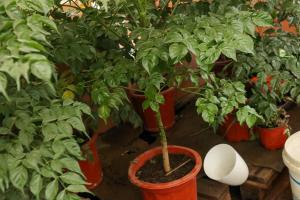How to Treat Black Spots on Tomato Plant Leaves
Tomatoes are one of the most popular vegetables (or fruits, as some people would argue) that people grow in their gardens. The joy of harvesting a basketful of ripe, juicy tomatoes is unparalleled. However, tomato plants are susceptible to various diseases and pests, and one of the most common problems gardeners face is black spots on tomato plant leaves.
What Are Black Spots on Tomato Plant Leaves?
Black spots on tomato plant leaves are one of the symptoms of a fungal disease called early blight. Early blight is caused by the fungus Alternaria solani and is characterized by dark spots on the lower leaves of tomato plants. As the disease progresses, the spots enlarge and turn brown with concentric rings, and eventually cause the leaves to yellow and die.
How to Prevent Early Blight
The best way to deal with early blight is to prevent it from occurring in the first place. Here are a few tips:
Rotate your crops: Do not plant tomatoes or other solanaceous plants (like peppers or eggplants) in the same spot year after year. Rotate crops to prevent the buildup of soil-borne pathogens.
Avoid overhead watering: Water your tomato plants at the base, not from above. Overhead watering can splash soil and spores onto the leaves, promoting fungal growth.
Keep foliage dry: Space your plants properly to allow good air circulation, and prune any suckers or leaves that touch the ground. This will help keep the foliage dry and reduce the risk of fungal growth.
Clean up debris: Remove any fallen leaves or plant debris from around your tomato plants. This will prevent fungal spores from overwintering in the soil and infecting your plants in the following season.
How to Treat Early Blight
If your tomato plants are already showing signs of early blight, here are a few steps you can take to treat the disease:
Remove infected leaves: As soon as you notice black spots on tomato plant leaves, remove them immediately. Do not compost infected leaves, as the spores can survive in the compost and infect your garden in the future.
Apply fungicides: There are several fungicides available that can help control early blight. Look for products that contain copper or chlorothalonil, and follow the manufacturer's instructions carefully.
Boost plant health: Healthy tomato plants are better able to fight off diseases. Make sure your plants are well-fed and watered, and consider applying a foliar spray of seaweed extract or a potassium-rich fertilizer to boost their immune system.
Consider companion planting: Some plants (like marigolds, chives, or garlic) are said to have anti-fungal properties and can help prevent early blight. Planting them near your tomato plants may help keep the disease at bay.
Conclusion
Black spots on tomato plant leaves may be a common problem, but they are not inevitable. By taking preventive measures and treating the disease early, you can keep your tomato plants healthy and productive.

 how many times do yo...
how many times do yo... how many planted tre...
how many planted tre... how many pine trees ...
how many pine trees ... how many pecan trees...
how many pecan trees... how many plants comp...
how many plants comp... how many plants can ...
how many plants can ... how many plants and ...
how many plants and ... how many pepper plan...
how many pepper plan...





























